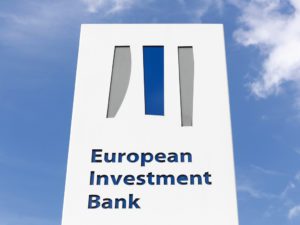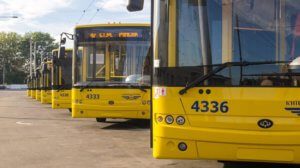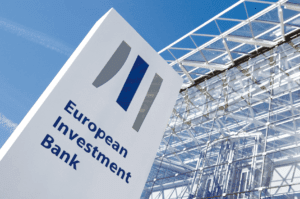
The European Investment Bank (EIB) has issued a long-term low-interest loan in the amount of EUR 200 million to the Cabinet of Ministers of Ukraine within the Early Recovery Program, Head of the EIB Representation in Ukraine Jean-Erik De Zagon has said, when opening six repaired medical facilities in Kharkiv.
According to him, the funds are used to invest in the restoration of key infrastructure objects in Donetsk and Luhansk regions, as well as to ensure adequate living conditions for internally displaced persons.
He noted that the purpose of the loan is to improve the living standards of people in Eastern Ukraine.
“Our Early Recovery Program was specifically developed to help people of Eastern Ukraine, including thousands of IDPs, deal with tough challenges they are facing following the armed conflict. This EUR 200 million program is part of our overall EUR 5.8 billion portfolio in Ukraine. It aims at improving living standards for people in terms of housing, healthcare and education. And it is a convincing proof that as an EU Priority Partner, Ukraine can greatly benefit from EU support and financing. We are happy to provide help where it is needed most and that it will directly impact the lives of ordinary citizens,” the banker said.

The European Investment Bank (EIB) will provide grant assistance to the State Agency of Automobile Roads of Ukraine (Ukravtodor) to develop a feasibility study for the construction of the Lviv-Mukachevo-Uzhgorod highway with a branch to the Hungarian border, the agency’s press service has reported. “This corridor is very important for Ukraine, because the export flow to the countries of Southern and South-Western Europe is directed through it. In addition, the new road will also provide a stable communication with Zakarpattia region,” Oleksandr Kava, the adviser to the Ukravtodor head, said.
According to the report, the new road will connect with the Hungarian M3 highway through the Dyida checkpoint and the Slovak D1 highway through the Uzhgorod checkpoint.
The maximum speed on the highway will be 130 km/h.
“This road will reduce the trip time in the direction of Lviv-Mukachevo to an hour and a half instead of the current 3.5 hours,” the report says.

The European Investment Bank (EIB) is considering Khrakiv region as one of the priority regions for cooperation in Ukraine and the bank is negotiating with Kharkiv authorities on the participation in the Safe City project, Head of EIB Resident Representation for Ukraine Jean-Erik De Zagon has said. In order to develop small and medium-sized enterprises (SME), it is necessary to create a good climate, De Zagon said at a briefing before the start of the Kharkiv SME Day Forum in Kharkiv on Tuesday.
The bank sees that in Kharkiv region there is indeed development in the medical field, as well as in the field of transport and education, much is being done to improve the infrastructure and living conditions, he said, adding that this is done thanks to the efforts of the local authorities and the bank.
His bank has already sent EUR 1.5 billion to the development of SME in Ukraine in general and plans to continue financing projects for SME,” the head of the EIB Resident Representation for Ukraine said.
Answering journalists’ questions, de Zagon confirmed that the EIB is negotiating with the authorities of Kharkiv on participation in the Safe City project.
The bank is at the negotiation stage. The bank has not yet reached any specific agreements, but we are moving very fruitfully along this path, de Zagon said.
Yesterday, in particular, he was shown a pilot dispatch center for city traffic control center that will be used for the road network and infrastructure to work well. The bank has already provided EUR 21 million for this and will continue to cooperate, he said.

Ukraine under the Ukraine Urban Public Transport Project of the European Investment Bank (EIB) plans to buy 227 buses, 153 trolleybuses, 56 trams and 35 subway wagons in 2019, according to a posting on the website of the Infrastructure Ministry.
“The Infrastructure Ministry together with the Finance Ministry and local governments (11 cities) are implementing the EIB project, which main goals are to implement subprojects in the cities of Ukraine to develop environmentally friendly and socially significant transport,” the ministry said.
The project provides for the renewal of the fleet of buses, trolleybuses, trams, metro cars, construction and reconstruction of tram and trolleybus lines, funicular, replacement of traction substations, introduction of modern fare collection systems and information systems using borrowed funds from the EIB and EBRD.
According to the Infrastructure Ministry, in particular, in 2018, under the project 167 trolleybuses were purchased, including 47 units for Odesa, 40 units for Kremenchuk, 23 trolleybuses delivered to Dnipro, 10 to Kremenchuk, and eight – to Kryvy Rih.
Thanks to these purchases, taking into account the trolleybus fleet in these cities as of January 1, 2018, Odesa has now updated its fleet by 28%, Kremenchuk – by 70%, Dnipro – by 17%, Rivne and Kryvy Rih – by 10% each.
As reported, in April 2017, Ukraine’s Verkhovna Rada passed a bill ratifying the financial agreement between Ukraine and the EIB under the Ukraine Urban Public Transport Project.
The approximate total cost of the project is EUR 400 million.

The European Investment Bank (EIB) agreed with the Ukrainian Government on a series of new financing operations, in particular, the sides signed an agreement on lending EUR 50 million to finance transport infrastructure improvements throughout the country and a grant of EUR 10 million to finance the implementation of the Ukraine Higher Education Project, the bank has said in a press release. “The projects signed today will result in faster and safer transport infrastructure, better academic facilities and more resources for higher education programmes, all of which will strengthen the country’s competitiveness,” the press service of the bank reported on Monday, citing EIB Vice-President Vazil Hudák.
The EUR 50 million EIB loan to improve connectivity in Ukraine and in the Eastern Neighbourhood provides support for transport projects expected to have significant positive local impacts. Road safety, connectivity, and traffic management and control projects are under consideration, with a view to contributing to the economic development of Ukraine.
The project’s first phase will focus on the development of intelligent transport system on national roads, the construction of a missing section of the northern by-pass around the city of Ternopil forming part of the extended TEN-T (Trans-European Transport Networks), and a number of multi-level railway crossings.
Furthermore, the project will support the development of future investment in railway connections between the European Union and Ukraine.
“The project is backed by a EUR 14 million EU grant for the Ternopil bypass investment and a EUR 1.85 million EU grant for project preparation and implementation. Both grants are being provided under the Neighbourhood Investment Platform (NIP),” the bank said.
Ukraine and the EIB also signed the EUR 10 million grant agreement under the multi-donor E5P fund that supports municipal investments in energy-efficiency and environmental projects in the Eastern Partnership countries.
“The grant will help finance the implementation of a Ukraine Higher Education Project, which the EIB is already supporting. Furthermore, the EIB concluded a Memorandum of Understanding with the Ukrainian Ministry of Education and Science for the preparation of a project to create several centres of excellence in the country,” the bank said.
The Ukraine Higher Education Project has already received a EUR 120 million loan from the EIB and EUR 30 million from Nordic Environment Finance Corporation (NEFCO), the EIB said.
The grant will be used to finance, in particular, seven universities in the cities of Chernihiv, Kharkiv, Kyiv, Lviv, Poltava, Sumy and Vinnitsa in order to significantly reduce the energy consumption of their buildings with positive environmental impacts.
The project is also supported by a EUR 3 million EU grant from the Neighbourhood Investment Facility (NIF) to assist implementation arrangements, the bank said.
According to the report, the agreements were signed at the EU-Ukraine Association Council meeting held in Brussels on Monday.

The European Investment Bank (EIB) agreed with the Ukrainian Government on a series of new financing operations, in particular, the sides signed an agreement on lending EUR 50 million to finance transport infrastructure improvements throughout the country and a grant of EUR 10 million to finance the implementation of the Ukraine Higher Education Project, the bank has said in a press release. “The projects signed today will result in faster and safer transport infrastructure, better academic facilities and more resources for higher education programmes, all of which will strengthen the country’s competitiveness,” the press service of the bank reported, citing EIB Vice-President Vazil Hudák.
The EUR 50 million EIB loan to improve connectivity in Ukraine and in the Eastern Neighbourhood provides support for transport projects expected to have significant positive local impacts. Road safety, connectivity, and traffic management and control projects are under consideration, with a view to contributing to the economic development of Ukraine.
The project’s first phase will focus on the development of intelligent transport system on national roads, the construction of a missing section of the northern by-pass around the city of Ternopil forming part of the extended TEN-T (Trans-European Transport Networks), and a number of multi-level railway crossings.
Furthermore, the project will support the development of future investment in railway connections between the European Union and Ukraine.
“The project is backed by a EUR 14 million EU grant for the Ternopil bypass investment and a EUR 1.85 million EU grant for project preparation and implementation. Both grants are being provided under the Neighbourhood Investment Platform (NIP),” the bank said.
Ukraine and the EIB also signed the EUR 10 million grant agreement under the multi-donor E5P fund that supports municipal investments in energy-efficiency and environmental projects in the Eastern Partnership countries.
“The grant will help finance the implementation of a Ukraine Higher Education Project, which the EIB is already supporting. Furthermore, the EIB concluded a Memorandum of Understanding with the Ukrainian Ministry of Education and Science for the preparation of a project to create several centres of excellence in the country,” the bank said.
The Ukraine Higher Education Project has already received a EUR 120 million loan from the EIB and EUR 30 million from Nordic Environment Finance Corporation (NEFCO), the EIB said.
The grant will be used to finance, in particular, seven universities in the cities of Chernihiv, Kharkiv, Kyiv, Lviv, Poltava, Sumy and Vinnitsa in order to significantly reduce the energy consumption of their buildings with positive environmental impacts.
The project is also supported by a EUR 3 million EU grant from the Neighbourhood Investment Facility (NIF) to assist implementation arrangements, the bank said.
According to the report, the agreements were signed at the EU-Ukraine Association Council meeting held in Brussels on Monday.